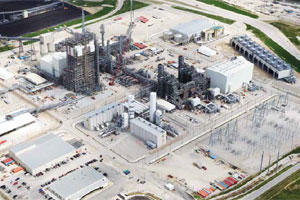EnergyControversial Mississippi power station to cut emissions by more than half
A new $5 billion state-of-the-art power facility is under construction Kemper County, Mississippi. It places a firm bet on the future of carbon-capture technology, and other technological advancements, including: it utilizes the gasification process with carbon in unique ways; it recycles treated wastewater to generate power; and it makes money from the carbon dioxide it has removed by selling it to oil companies for their own extraction. Critics say that investing so much money in untested technologies is too much of a gamble.

Mississippi's Kemper coal-fired power plant under construction // Source: doe.gov
Rooted near De Kalb, in Kemper County, Mississippi a new $5 billion state-of-the-art power facility is under construction. It places a firm bet on the future of carbon-capture with resources such as coal. The Kemper plant, scheduled to open later this year, is the latest effort to curtail greenhouse gases emissions and meet or exceed the EPA’s proposed 40 percent reduction in such emissions by power plants. The Pittsburgh Post Gazette reports that Southern Co., the parent corporation, eying the relatively stable price of coal in relation to natural gas, and responding to the EPA’s stricter production laws, sees necessary changes — as well as potential profits — once the technological advancements are in place for such a resource.
Among those advancements: it utilizes the gasification process with carbon in unique ways. Also, the facility is near a coal mine, it recycles treated wastewater to generate power, and makes money from the carbon dioxide it has removed by selling it to oil companies for their own extraction. Purportedly, the plant will serve 189,000 customers.
Edward S. Rubin, a professor of public policy and engineering at Carnegie Melon University, told the Post Gazette, “If you think that it’s a sound bet that coal will be part of the future of the country, if have an interest in coal, and companies like Southern do, it makes good business sense to develop technology that lets you use the resource in a way that is socially acceptable.” Further, the facility receives the blessing of former energy secretary Steven Chu, who said, “This project is of national importance because it provides a viable option for using our abundant coal resources in a cost-effective and clean manner.”
Others, however, see the facility in an entirely different light. “There’s a realistic chance that one or all may never get built,” Howard Herzog, an MIT Energy Initiative research engineer, told the Post Gazette. Herzog’s skepticism stems from the fact that the project costs $1 billion more than a standard facility, for untested technology, with a grand total of $3.4 billion being allocated by the U.S. Department of Energy (DOE). Rumors of construction cost overruns abound.
Duke University energy systems Professor Dalia Patino Echeverri echoes this concern, saying, “if your choice is you can start a plant with proven technology like a natural gas plant, or unproven expensive technology, you will build a gas plant.”
